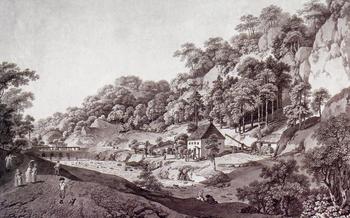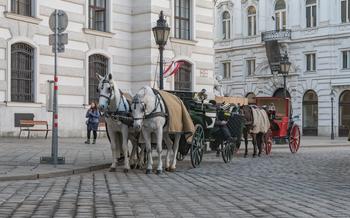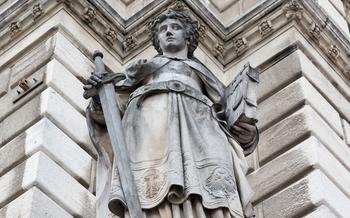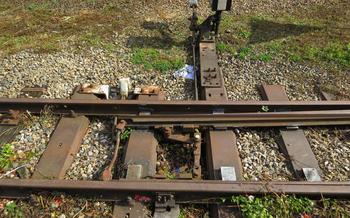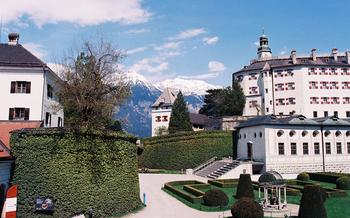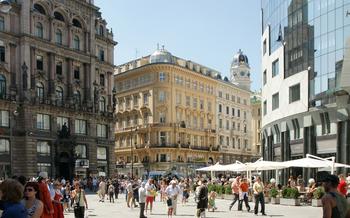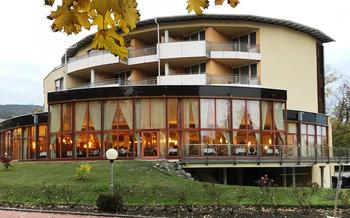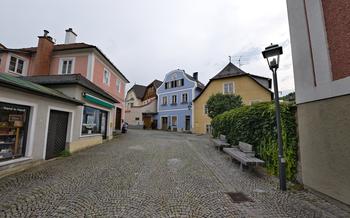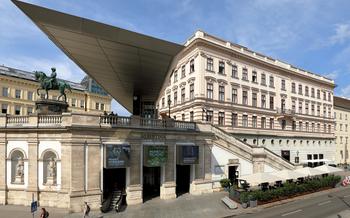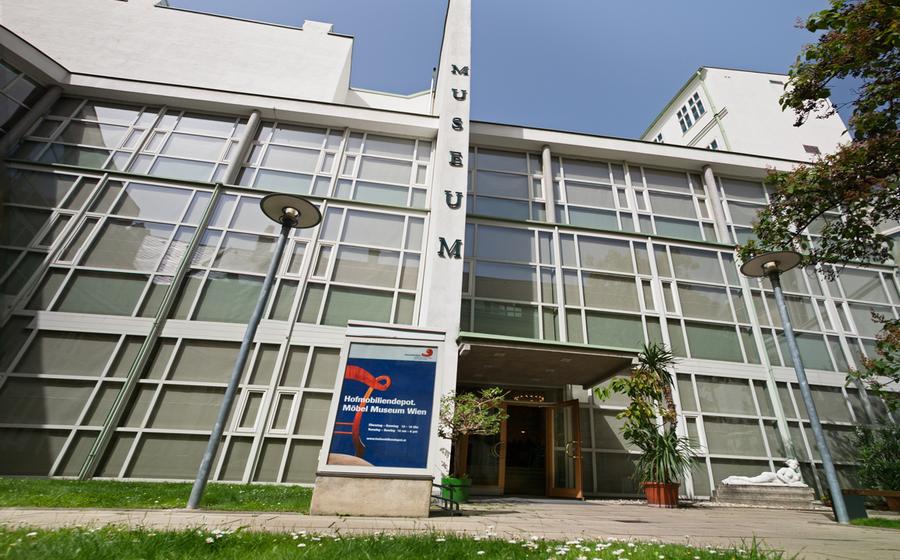
Imperial Furniture Collection
- Hofburg Palace: A Majestic Setting
- Imperial Furniture Collection: A Glimpse into Royal Splendor
- Exploring the Imperial Apartments
- Imperial Silver Collection: A Feast for the Eyes
- Spanish Riding School: A Legacy of Equestrian Excellence
- Hofburg Chapel: A Sacred Space
- Practical Information
- National Library: A Treasury of Knowledge
- Museum of Fine Arts: A Masterpiece Gallery
- Albertina Museum: A Home for Graphic Arts
- Naschmarkt: A Culinary Adventure
- Insider Tip: Hidden Gems of the Hofburg
Hofburg Palace: A Majestic Setting
The Hofburg Palace, a former imperial residence, stands as a testament to the grandeur of the Habsburg dynasty. Immerse yourself in its rich history as you wander through its vast courtyards, elegant state rooms, and impressive museums. Admire the architectural masterpieces that adorn the palace complex, including the Heldenplatz, a vast square lined with statues of Austrian rulers, and the Michaelertor, an ornate gate that leads to the Imperial Apartments. Explore the various wings of the palace, each with its own unique story to tell, and discover the treasures they hold. Practical tips: To fully experience the Hofburg Palace, purchase a Sisi Ticket, which grants access to the Imperial Apartments, the Imperial Silver Collection, and the Sisi Museum. Plan your visit to coincide with one of the many concerts or events held in the palace's opulent halls.
Imperial Furniture Collection: A Glimpse into Royal Splendor
Step into the opulent world of the Habsburg dynasty at the Imperial Furniture Collection. Housed within the Hofburg Palace, this extraordinary collection showcases the exquisite furnishings and decorative arts that adorned the imperial residences. Immerse yourself in the grandeur of royal life as you explore the vast array of furniture, tapestries, and other treasures that once graced the palaces and castles of the Habsburgs.
The collection boasts a remarkable diversity of styles, from the Renaissance to the Baroque and beyond. Admire the intricate carvings, opulent fabrics, and delicate porcelain that adorn the furniture, each piece a testament to the craftsmanship and artistry of its time. Discover the stories behind the furniture, learning how it was used in the daily lives of the Habsburg emperors and empresses.
Highlights of the collection include the magnificent state beds, adorned with intricate carvings and luxurious fabrics. Marvel at the grandeur of the ceremonial chairs, designed to impress and intimidate visitors. Explore the private apartments of the imperial family, where you can see the more personal furnishings and decorations that reflected their tastes and preferences.
Visiting the Imperial Furniture Collection is a journey through time, offering a glimpse into the lavish lifestyle of the Habsburgs. It's an opportunity to admire the exquisite craftsmanship and artistry that defined their reign and to experience the grandeur of imperial Vienna.
Practical Information:
- Location: Hofburg Palace, Vienna
- Opening Hours: Daily, 9 am - 5 pm
- Admission: Included in the Hofburg Palace ticket (17 euros for adults, 12 euros for students and seniors)
- Guided Tours: Available in English and German (check for schedules and prices)
Exploring the Imperial Apartments
Immerse yourself in the private lives of the Habsburg emperors and empresses as you wander through the opulent Imperial Apartments. These lavishly decorated rooms once served as the living quarters of the imperial family, offering a glimpse into their grandeur and everyday life.
Marvel at the grand state rooms, designed to impress guests and showcase the power of the monarchy. Adorned with intricate tapestries, gleaming chandeliers, and gilded furniture, these rooms were used for official ceremonies, receptions, and balls.
Step into the more intimate audience chambers, where the emperors conducted official business and received visitors. These rooms are furnished with elegant desks, ornate chairs, and valuable artwork, reflecting the taste and personality of each ruler.
Don't miss the private living quarters, where the imperial family sought refuge from the public eye. These rooms offer a glimpse into their personal lives, with comfortable sitting rooms, cozy bedrooms, and luxurious bathrooms.
Admire the exquisite furnishings, artwork, and personal belongings of the imperial family. From ornate beds and grand pianos to treasured family portraits and delicate china, these items provide a tangible connection to the lives of the Habsburgs.
Practical Tips:
- Guided tours are available to provide insights into the history and significance of the Imperial Apartments.
- Advance booking is recommended to avoid long queues, especially during peak season.
- Photography is generally allowed, but using a flash is prohibited to preserve the delicate furnishings.
- Allow ample time to explore the Imperial Apartments, as there is much to see and appreciate.
Imperial Silver Collection: A Feast for the Eyes
The Imperial Silver Collection is a testament to the opulence and grandeur of the Habsburg dynasty. Housed within the Hofburg Palace, this collection showcases a dazzling array of silverware that once graced the imperial tables.
Highlights of the collection include exquisite tableware, centerpieces, and decorative objects crafted from the finest silver. Admire the intricate designs, delicate engravings, and opulent ornamentation that adorn these pieces. Each item tells a story of imperial banquets, lavish receptions, and grand ceremonies.
Discover the history and use of this silverware in imperial rituals and everyday life. Learn about the meticulous craftsmanship involved in its creation and the significance of the various symbols and motifs that decorate these precious objects.
Practical information: The Imperial Silver Collection is open to the public as part of the Hofburg Palace tour. Guided tours are available, providing insights into the collection's history and significance. Remember to check the official website for admission fees and opening hours before your visit.
Spanish Riding School: A Legacy of Equestrian Excellence
Immerse yourself in the grandeur of imperial transportation at the Carriage Museum. Highlights of the collection include state carriages, ceremonial sleighs, and travel coaches. Learn about the history and use of these magnificent carriages in imperial processions and events. Practical information for visiting the Imperial Carriage Museum is available on the museum's website.
The Spanish Riding School, with its centuries-old tradition of equestrian excellence, is a must-see for any visitor to Vienna. Witness the grace and precision of the Lipizzaner horses and riders in their daily training sessions, and attend a performance of the famous White Stallions in the opulent Winter Riding School.
The Spanish Riding School was founded in 1572 by Emperor Maximilian II and has been training Lipizzaner horses for over 450 years. The horses, known for their intelligence and athleticism, are carefully bred and trained to perform intricate dressage movements.
The daily training sessions are open to the public, and visitors can watch the horses and riders as they practice their routines. The sessions are held in the Winter Riding School, a magnificent Baroque building that dates back to the 17th century.
The highlight of a visit to the Spanish Riding School is a performance of the White Stallions. These performances, which take place several times a week, feature the horses and riders performing a series of intricate dressage movements, accompanied by classical music.
The Spanish Riding School is a unique and unforgettable experience that offers a glimpse into the world of imperial Vienna. Visitors can learn about the history of the school, the training of the horses, and the art of dressage.
Practical Information for Visiting the Spanish Riding School:
- The Spanish Riding School is located in the Hofburg Palace complex, in the center of Vienna.
- The daily training sessions are held at 10:00 am and 3:00 pm, and tickets can be purchased online or at the door.
- Performances of the White Stallions are held several times a week, and tickets can be purchased online or at the door.
- Visitors can also take a guided tour of the school, which includes a visit to the stables and the training grounds.
- The Spanish Riding School is a popular tourist attraction, so it is advisable to book tickets in advance.
Hofburg Chapel: A Sacred Space
Nestled within the grand walls of the Hofburg Palace, the Hofburg Chapel stands as a testament to the deep-rooted faith of the Habsburg dynasty. Built in the 13th century, this Baroque masterpiece has borne witness to centuries of imperial ceremonies, religious services, and sacred performances.
As you step through its ornate entrance, you are greeted by a symphony of colors, intricate frescoes, and gleaming sculptures. The chapel's interior is a testament to the artistic prowess of the time, with its vaulted ceilings adorned with breathtaking murals depicting scenes from the life of Christ and the Holy Trinity. The intricate carvings and delicate stucco work that adorn the walls add to the chapel's sacred atmosphere, creating a sense of awe and reverence.
The centerpiece of the chapel is the magnificent high altar, a masterpiece of Baroque craftsmanship. Its towering structure, adorned with marble, gold leaf, and intricate carvings, is a testament to the Habsburgs' devotion to their faith. The altar is flanked by two impressive organs, their sonorous tones filling the chapel with heavenly music during religious services and concerts.
Beneath the altar lies the imperial crypt, where many members of the Habsburg dynasty found their final resting place. Elaborate sarcophagi, adorned with intricate carvings and crowned with life-size bronze sculptures, pay tribute to the illustrious rulers who once graced the halls of the Hofburg. Among them, the most notable is the tomb of Emperor Franz Joseph I and Empress Elisabeth, whose love story continues to captivate hearts to this day.
Whether you are a devout believer seeking spiritual nourishment or a history enthusiast drawn to the grandeur of the past, the Hofburg Chapel is a must-visit destination. Its sacred atmosphere, stunning architecture, and historical significance make it an unforgettable experience that will leave you in awe.
Practical Information
- Visiting Hours: The Hofburg Chapel is open to the public from 9am to 5pm, Monday to Saturday. It is closed on Sundays and public holidays.
- Admission: Admission is free of charge.
- Dress Code: Visitors are expected to dress respectfully when entering the chapel. Shorts, tank tops, and revealing clothing are not permitted.
- Photography: Photography is allowed inside the chapel, but the use of flash is prohibited.
- Accessibility: The chapel is wheelchair accessible.
National Library: A Treasury of Knowledge
Nestled within the Hofburg Palace complex, the National Library of Austria stands as a testament to the country's rich cultural heritage. Enter this grand repository of knowledge and be transported to a world of literary wonders.
The library's vast collection boasts over 12 million books, manuscripts, and artifacts, spanning centuries of human thought and creativity. Among its treasures are medieval manuscripts adorned with intricate illuminations, rare books printed on vellum, and a collection of globes that chart the course of human exploration.
The heart of the library is the magnificent State Hall, a breathtaking spectacle of Baroque architecture. Its soaring ceiling is adorned with frescoes depicting scenes from mythology and history, while marble statues of scholars and philosophers line the walls. Here, you can marvel at the sheer scale and splendor of this temple to knowledge.
Practical Information:
- Location: Josefsplatz 1, 1015 Vienna, Austria
- Hours: Monday-Friday, 9 am - 7 pm; Saturday, 9 am - 4 pm
- Admission: Adults €15, Students/Seniors €12, Children (under 14) Free
- Guided Tours: Available in English and German, pre-booking recommended
Tips:
- Allow at least two hours to fully explore the library's collection.
- Don't miss the Papyrus Museum, which houses a collection of ancient Egyptian papyri.
- Take advantage of the library's free Wi-Fi to research your favorite topics.
- Visit the library's website to learn about upcoming events and exhibitions.
Museum of Fine Arts: A Masterpiece Gallery
Nestled in the heart of Vienna's cultural district, the Museum of Fine Arts (Kunsthistorisches Museum) is a treasure trove of artistic wonders. Its grand neo-Renaissance building houses one of the world's most impressive collections of paintings, sculptures, and decorative arts, spanning from ancient times to the present day.
Highlights of the collection include masterpieces by Albrecht Dürer, whose intricate self-portrait is a testament to his technical prowess; Rembrandt's deeply moving "The Jewish Bride"; and Gustav Klimt's golden masterpiece, "The Kiss." The museum also boasts an exceptional collection of Italian Renaissance paintings, including works by Titian, Tintoretto, and Veronese.
Explore the various galleries to discover the evolution of art and artistic styles over the centuries. From the ancient Egyptian and Greek sculptures to the medieval and Baroque masterpieces, the Museum of Fine Arts offers a comprehensive journey through the history of art.
Practical Information:
- Address: Burgring 5, 1010 Vienna, Austria
- Opening hours: Daily from 10 am to 6 pm, except on Mondays when the museum is closed.
- Admission: Adults €18, seniors €14, students €12
- Guided tours: Available in English and German for an additional fee.
- Website: Kunsthistorisches Museum
Albertina Museum: A Home for Graphic Arts
Nestled in the heart of Vienna's historic center, the Albertina Museum stands as a testament to the city's rich artistic heritage. Renowned for its exceptional collection of graphic arts, the museum invites visitors on a journey through the world of drawings, watercolors, and prints.
Established in 1776 as a private collection by Duke Albert of Saxe-Teschen, the Albertina has grown into one of the most significant graphic art museums globally. Its collection spans over a million works, ranging from the Renaissance to the present day, showcasing the evolution of artistic expression across centuries.
Among the highlights of the collection are the exquisite drawings of Albrecht Dürer, whose mastery of line and detail is evident in works like "The Praying Hands." Visitors can also marvel at the vibrant watercolors of J.M.W. Turner, capturing the essence of light and atmosphere in his landscapes. The museum's holdings also include a remarkable collection of prints by Rembrandt, showcasing his innovative techniques and mastery of chiaroscuro.
Beyond the Old Masters, the Albertina also houses an impressive collection of modern and contemporary art. Visitors can explore works by Pablo Picasso, Andy Warhol, and Friedensreich Hundertwasser, gaining insights into the diverse artistic movements that have shaped the 20th and 21st centuries.
With its rich collection and captivating exhibitions, the Albertina Museum offers a unique perspective on the history of graphic arts. Whether you're an art enthusiast, a student, or simply curious about the creative process, a visit to this hidden gem is sure to leave a lasting impression.
Practical Information:
- Address: Albertinaplatz 1, 1010 Vienna, Austria
- Opening Hours: Tuesday-Sunday: 10:00 am - 6:00 pm
- Admission: Adults: €90, Concessions: €90
- Guided Tours: Available in English and German
- Accessibility: The museum is wheelchair accessible with elevators and ramps throughout.
Naschmarkt: A Culinary Adventure
Immerse yourself in the vibrant atmosphere of the Naschmarkt, Vienna's largest and most beloved market. This bustling marketplace is a foodie's paradise, offering a tantalizing array of fresh produce, exotic spices, artisanal cheeses, and succulent meats from around the world.
As you stroll through the colorful stalls, let your senses be captivated by the vibrant hues and enticing aromas that fill the air. Discover hidden culinary treasures, from freshly baked pastries and artisan breads to homemade jams and pickles. Indulge in a variety of local delicacies, such as Viennese sausages, freshly shucked oysters, and traditional Austrian pastries.
Take a break from your shopping adventure and savor a delicious meal at one of the many restaurants and cafes that line the market. From traditional Austrian cuisine to international flavors, there's something to satisfy every palate. Sip on a refreshing glass of wine or indulge in a frothy Viennese coffee as you watch the world go by.
The Naschmarkt is not just a place to shop and eat; it's also a vibrant social hub where locals and visitors alike come together to connect and celebrate. Experience the infectious energy and warm hospitality that make this market so beloved.
Practical Information:
- Location: The Naschmarkt is located in the 4th district of Vienna, between Karlsplatz and Kettenbrückengasse.
- Opening hours: The market is open from Monday to Saturday, with most stalls operating from 6 am to 6 pm. Some restaurants and cafes may have different opening hours.
- Getting there: The Naschmarkt is easily accessible by public transportation. Take the U4 subway line to Kettenbrückengasse station or the U1 line to Karlsplatz station.
- Tips for visitors: Be sure to bring cash as many vendors do not accept credit cards. Remember your shopping bags to carry your market finds. The Naschmarkt is a popular tourist destination, so be prepared for crowds, especially on weekends.
Insider Tip: Hidden Gems of the Hofburg
Beyond the grand halls and museums, the Hofburg Palace holds a treasure trove of hidden gems waiting to be discovered. For those who seek a unique and off-the-beaten-path experience, here are some insider tips:
-
Secret Passageways: Discover the secret passageways that once allowed the Habsburgs to move discreetly throughout the palace. These hidden corridors and stairways offer a glimpse into the private lives of the imperial family.
-
Burgtheater: Step into the grandeur of the Burgtheater, one of the most prestigious theaters in the world. Admire its opulent interior, adorned with crystal chandeliers and plush red velvet seats, and catch a performance of a classic play or opera.
-
Hofburg Gardens: Escape the hustle and bustle of the city in the serene Hofburg Gardens. Stroll along the manicured paths, admire the blooming flowers, and find a quiet spot to relax and soak in the tranquility.
-
Practical Tips: To uncover these hidden gems, be sure to book a guided tour that includes access to restricted areas. Check the Hofburg Palace website for tour schedules and availability.
